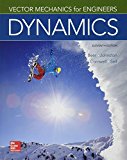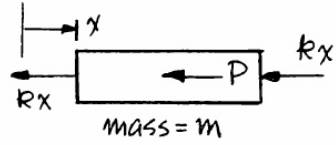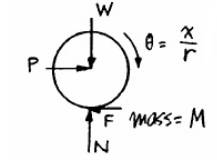
Concept explainers
A 6-kg uniform cylinder can roll without sliding on a horizontal surface and is attached by a pin at point C to the 4-kg horizontal bar AB. The bar is attached to two springs, each having a constant of

(a)
The period of vibration of the given system.
Answer to Problem 19.39P
Period of vibration,
Explanation of Solution
Given information:

Mass of cylinder
Mass of bar
Amplitude
Spring constant
Firstly we draw the free body diagram of the bar and the cylinder separately and calculate forces acting upon them. For the bar;

But,
Then,
Now, for the disc,

Now, moment of inertia at point C,
Put the values of equation (1) and (3) in equation (2);
Here,
Compare the above equation with un-damped equation of vibration;
Thus, the time period:
(b)
The maximum velocity of bar AB.
Answer to Problem 19.39P
Velocity,
Explanation of Solution
Given information:

Mass of cylinder
Mass of bar
Amplitude
Spring constant
Firstly, we draw the free body diagram of the bar and the cylinder separately and calculate forces acting upon them. For the bar;

But,
Then,
Now, for the disc,

Now, moment of inertia at point C,
Put the values of equation (1) and (3) in equation (2);
Here,
Compare the above equation with un-damped equation of vibration;
Now, maximum velocity:
Want to see more full solutions like this?
Chapter 19 Solutions
Package: Vector Mechanics For Engineers: Dynamics With 1 Semester Connect Access Card
Additional Engineering Textbook Solutions
Machine Tool Practices (10th Edition)
Engineering Mechanics: Dynamics (14th Edition)
Mechanics of Materials
Applied Statics and Strength of Materials (6th Edition)
INTERNATIONAL EDITION---Engineering Mechanics: Statics, 14th edition (SI unit)
Thermodynamics: An Engineering Approach
- A 45-kg motor is bolted to a light horizontal beam that has a static deflection of 6 mm due to the weight of the motor. The unbalance of the motor is equivalent to a mass of 110 g located 75 mm from the axis of rotation. Knowing that the amplitude of the vibration of the motor is 0.25 mm at a speed of 300 rpm, determine (a) the damping factor c/cc(b) the coefficient of damping c.arrow_forwardA uniform disk of radius r = 120 mm is welded at its center to two elastic rods of equal length with fixed ends at A and B. Knowing that the disk rotates through an 8° angle when a 500-mN.m couple is applied to the disk and that it oscillates with a period of 1.3 s when the couple is removed, determine (a) the mass of the disk, (b) the period of vibration if one of the rods is removed.arrow_forwardThe 6-kg uniform rod AC is attached to springs of constantk = 500 N/m at B and k = 620 N/m at C, which can act in tensionor compression. If the end C of the rod is depressed slightly andreleased, determine (a) the frequency of vibration, (b) the amplitudeof the motion of Point C, knowing that the maximum velocity of thatpoint is 0.9 m/s.arrow_forward
- An 8-kg uniform disk of radius 200 mm is welded to a vertical shaft with a fixed end at B. The disk rotates through an angle of 3° when a static couple of magnitude 50N.m is applied to it. If the disk is acted upon by a periodic torsional couple of magnitude Tm=60N.m. determine the range of values of vf for which the amplitude of the vibration is less than the angle of rotation caused by a static couple of magnitude Tm.arrow_forwardA 180-kg motor is bolted to a light horizontal beam. The unbalance of its rotor is equivalent to a 28-g mass located 150 mm from the axis of rotation, and the static deflection of the beam due to the weight of the motor is 12 mm. The amplitude of the vibration due to the unbalance can be decreased by adding a plate to the base of the motor. If the amplitude of vibration is to be less than 60 μm for motor speeds above 300 rpm, determine the required mass of the plate.arrow_forwardShow that for a small value of the damping factor c/cc , the maximum amplitude of a forced vibration occurs when Wf= Wn and that the corresponding value of the magnification factor is ½ (c/c2).arrow_forward
- A 64-lb block is attached to a spring with a constant of k = 1 kip/ft and can move without friction in a vertical slot as shown. It is acted upon by a periodic force with a magnitude of P=Pm sin wf t = 10 rad/s. Knowing that the amplitude of the motion is 0.75 in., determine Pm.arrow_forwardA vibrometer used to measure the amplitude of vibrations consists essentially of a box containing a mass-spring system with a known natural frequency of 120 Hz. The box is rigidly attached to a surface that is moving according to the equation y= δm sin wf t. If the amplitude zm of the motion of the mass relative to the box is used as a measure of the amplitude δm of the vibration of the surface, determine (a) the percent error when the frequency of the vibration is 600 Hz,(b) the frequency at which the error is zero.arrow_forwardA machine of mass 75 kg is mounted on springs and is fitted with a dashpot to damp out vibrations. There are three springs each of stiffness 10 N/mm and it is found that the amplitude of vibration diminishes from 38.4 mm to 6.4 mm in two complete oscillations. Assuming that the damping force varies as the velocity, determine : 1. the resistance of the dash-pot at unit velocity ; 2. the ratio of the frequency of the damped vibration to the frequency of the undamped vibration ; and 3. the periodic time of the damped vibration.arrow_forward
- A motor of mass M is supported by springs with an equivalent spring constant k The unbalance of its rotor is equivalent to a mass m located at a distance r from the axis of rotation. Show that when the angular velocity of the motor is wf, the amplitude of the motion of the motor is wherearrow_forwardA 360-lb motor is supported by springs of total constant 12.5 kips/ft. The unbalance of the rotor is equivalent to a 0.9-oz weight located 7.5 in. from the axis of rotation. Determine the range of speeds of the motor for which the amplitude of the fluctuating force exerted on the foundation is less than 5 lb.arrow_forwardTwo springs of constants K1 and K2 are connected in series to a block A that vibrates in simple harmonic motion with a period of 5 s. When the same two springs are connected in parallel to the same block, the block vibrates with a period of 2 s. Determine the ratio K1/K2 of the two spring constants.arrow_forward
 Elements Of ElectromagneticsMechanical EngineeringISBN:9780190698614Author:Sadiku, Matthew N. O.Publisher:Oxford University Press
Elements Of ElectromagneticsMechanical EngineeringISBN:9780190698614Author:Sadiku, Matthew N. O.Publisher:Oxford University Press Mechanics of Materials (10th Edition)Mechanical EngineeringISBN:9780134319650Author:Russell C. HibbelerPublisher:PEARSON
Mechanics of Materials (10th Edition)Mechanical EngineeringISBN:9780134319650Author:Russell C. HibbelerPublisher:PEARSON Thermodynamics: An Engineering ApproachMechanical EngineeringISBN:9781259822674Author:Yunus A. Cengel Dr., Michael A. BolesPublisher:McGraw-Hill Education
Thermodynamics: An Engineering ApproachMechanical EngineeringISBN:9781259822674Author:Yunus A. Cengel Dr., Michael A. BolesPublisher:McGraw-Hill Education Control Systems EngineeringMechanical EngineeringISBN:9781118170519Author:Norman S. NisePublisher:WILEY
Control Systems EngineeringMechanical EngineeringISBN:9781118170519Author:Norman S. NisePublisher:WILEY Mechanics of Materials (MindTap Course List)Mechanical EngineeringISBN:9781337093347Author:Barry J. Goodno, James M. GerePublisher:Cengage Learning
Mechanics of Materials (MindTap Course List)Mechanical EngineeringISBN:9781337093347Author:Barry J. Goodno, James M. GerePublisher:Cengage Learning Engineering Mechanics: StaticsMechanical EngineeringISBN:9781118807330Author:James L. Meriam, L. G. Kraige, J. N. BoltonPublisher:WILEY
Engineering Mechanics: StaticsMechanical EngineeringISBN:9781118807330Author:James L. Meriam, L. G. Kraige, J. N. BoltonPublisher:WILEY





